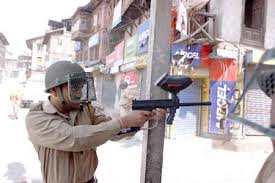Deadly ‘non-lethal’ weapon life risk for civilians, cops
 Harvey Allen in Toward the Flame: A Memoir of World War-I writes, “It was remarked as a joke that if someone yelled ‘Gas’, everyone in France would put on a mask. … Gas shock was as frequent as shell shock.”
Harvey Allen in Toward the Flame: A Memoir of World War-I writes, “It was remarked as a joke that if someone yelled ‘Gas’, everyone in France would put on a mask. … Gas shock was as frequent as shell shock.”Not much has changed for the people of Kashmir who are as shell shocked today due to the excessive use of pepper gas by police and paramilitary forces.
The rampant use of the “non-lethal” pepper gas is becoming deadly for people in Kashmir and occupational hazard for policemen.
The government has been using pepper gas or Oleoresin Capsicum, a chemical compound that irritates eyes to cause tears, pain, and temporary blindness, as a non-lethal weapon to crackdown on protestors.
However, this non-lethal weapon is becoming deadly for people particularly elderly, children and those having asthma.
“It seems we are back to Hitler’s era,” 68-year-old Muhammad Aslam Gagroo of Kamangarpora area of Srinagar downtown said. “Hitler killed Jews in gas chambers and Police is killing Kashmiri Muslims on streets and inside their houses.”
Pepper gas has been deadly in some cases and concerns have been raised about a number of deaths where pepper spray might have been a contributing factor.
The wife of Mujtaba Nazki, who lives near the Mirwaiz Manzil at Rajouri Kadal, almost collapsed when police sprayed pepper gas in their compound after chasing away youth last Friday.
Nazki said Police while withdrawing from the downtown in the evenings burst pepper gas, and use it excessively and unnecessarily even during curfew when there is no movement of youth or protestors.
“We recently had three deaths due to pepper gas use including the death of a three-month infant near Jamia Masjid and a pregnant woman of Saraf Kadal,” he said. “In all the three cases, doctors confirmed to the families that they had died of suffocation due to pepper spray.”
Nazki said he had brought the issue to the notice of Police but there was no stopping on pepper gas use.
Capsaicin, a chemical derived from the fruit of plants in the Capsicum genus, including chilis, is an active ingredient in pepper gas.
A doctor posted at the Chest Disease (CD) Hospital in Srinagar, who is not authorized to talk to the media, said they get patients who relate their illness to pepper spray.
The CD Hospital has been witnessing a rush of patients particularly from downtown with complaints of chest ailments due to exposure to pepper gas in their localities.
Most of these patients were elderly people, children and those suffering from asthma and also policemen who constantly fire pepper gas and tear smoke canisters at people.
The policemen and paramilitary troopers, who fire these deadly chemicals, also put their health and lives in danger.
“It is more problematic for asthma patients and people with problems in lungs and suffering other respiratory ailments,” the doctor at CD Hospital said. “It is an occupational hazard for such policemen who are actively involved in spraying the pepper gas.”
The Journal of Investigative Ophthalmology and Visual Science published a study that concluded that repeated exposure to pepper gas can result in long-lasting changes in corneal sensitivity.
Chairman of the All Parties Hurriyat Conference (M), Mirwaiz Umar Farooq condemned the government for using pepper gas on the people of Kashmir in general and downtown in particular.
“Whenever people raise voice, they are dealt with pepper gas and tear gas canisters, which release deadly chemicals and become dangerous for the health of the people particularly the aged, children and the ailing,” he said.
The European Parliament Scientific and Technological Options Assessment (STOA) published ‘An Appraisal of Technologies of Political Control’ with extensive information on pepper spray and tear gas.
It wrote that the effects of pepper spray are far more severe, including temporary blindness, a burning sensation of the skin, upper body spasms and uncontrollable coughing making it difficult to breathe or speak.
Deputy Inspector General (DIG), Kashmir, Ghulam Hassan Bhat told that pepper gas is a non-lethal weapon but the problem with it is that the gas spreads in the area.
“The elderly people, the saner elements and the religious heads of the locality should intervene and persuade youth indulging in stone pelting not to create problems for such people,” Bhat said.
According to experts, eyeglasses, sunglasses, and other protective eyewear and clothing may greatly reduce the effectiveness of pepper gas.
Dr Riyaz Antoo, Head of the Department of Ophthalmology, SKIMS (JVC), said they have been receiving complaints from patients about acute allergies in their eyes.
“Pepper gas is toxic and an irritant and we get patients who complain about irritation in their eyes,” he said.
PEPPER GAS FACTS
• A secret martial art society of people in ancient Japan called the Ninjas used grounded pepper for disabling their opponents for a long time.
• In the Tukagawa Empire era in Japan, the police used a weapon called Metsubishi, which was basically a box consisting of chili pepper. Police used this box for blowing hot pepper into the eyes of people who were found guilty of some crime.
• In Mexico, a form of pepper gas was used as back as 7000 BC.
• Pepper gas was also used as a weapon in the 14th and 15th century when slavery was rampant.
• Pepper was used as a popular method for torturing people, criminals, and slaves.
• US Postal service workers used pepper gas against dogs and other pets.
• It is illegal to use pepper spray, mace or tear gas in Canada.




